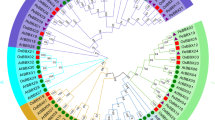Abstract
The B-box proteins (BBXs) are a class of zinc finger transcription factors containing one or two B-BOX domains that play important roles in plant growth, development and stress response. The petunia (Petunia hybrida) is a model ornamental plant, and its draft genome has been published. However, no systematic study of the BBX gene family in Petunia has been reported. In this study, a total of 28 BBX members from the Petunia genome were identified. We performed analyses of their phylogenetic relationships, structures, conserved motifs, promoter regions, and expression patterns. Based on the phylogenetic relationship, the PhBBXs were divided into six groups. Analysis of the gene structures and conserved motifs further confirmed the closer relationships in each group. Based on the RNA-seq data, the transcript abundance of PhBBXs in different tissues were divided into two major groups. The analysis of cis-elements showed that many stress responsive elements appeared in the promoter region of most PhBBX genes. The stress response patterns of PhBBXs were detected under drought, salinity, cold and heat treatments. Based on the RNA-seq data, we found that 3 genes responded to drought, 8 genes responded to salt, 18 genes responded to cold, and 15 genes responded to heat. In conclusion, this study may facilitate further functional studies of BBXs in Petunia.






Similar content being viewed by others
Data availability
The datasets generated during and/or analyzed during the current study are available from the corresponding author on reasonable request.
References
Chu Z, Wang X, Li Y, Yu H, Li J, Lu Y, Li J, Lu Y, Li H, Ouyang B (2016) Genomic organization, phylogenetic and expression analysis of the B-Box genefamily in tomato. Front Plant Sci 7:1–15. https://doi.org/10.3389/fpls.2016.01552
Gangappa SN, Botto JF (2014) The BBX family of plant transcription factors. Trends Plant Sci 19:460–470. https://doi.org/10.1016/j.tplants.2014.01.010
Khanna R, Kronmiller B, Maszle DR, Coupland G, Holm M, Mizuno T, Wu SH (2009) The arabidopsis B-Box zinc finger family. Plant Cell 21:3416–3420. https://doi.org/10.1105/tpc.109.069088
Gendron JM, Pruneda-Paz JL, Doherty CJ, Gross AM, Kang SE, Kay SA (2012) Arabidopsis circadian clock protein, TOC1, is a DNA-binding transcription factor. Proc Natl Acad Sci USA 109:3167–3172. https://doi.org/10.1073/pnas.1200355109
Yan H, Marquardt K, Indorf M, Jutt D, Kircher S, Neuhaus G, Franco MR (2011) Nuclear localization and interaction with COP1 are required for STO/BBX24 function during Photomorphogenesis. Plant Physiol 156:1772–1782. https://doi.org/10.1104/pp.111.180208
Huang J, Zhao X, Weng X, Wang L, Xie W (2012) The rice B-Box zinc finger gene family: genomic identification, characterization, expression profiling and diurnal analysis. PLoS ONE 7:15–17. https://doi.org/10.1371/journal.pone.0048242
Zou Z, Wang R, Wang R, Yang S, Yang Y (2018) Genome-wide identification, phylogenetic analysis, and expression profiling of the BBX family genes in pear. J Hortic Sci Biotechnol 93:37–50. https://doi.org/10.1080/14620316.2017.1338927
Liu X, Li R, Dai Y, Chen X, Wang X (2018) Genome-wide identification and expression analysis of the B-box gene family in the Apple (Malus domestica Borkh.) genome. Mol Genet Genomics 293:303–315. https://doi.org/10.1007/s00438-017-1386-1
An H, Roussot C, Suárez-López P, Corbesier L, Vincent C, Piñeiro M, Hepworth S, Mouradov A, Justin S, Turnbull C, Coupland G (2004) CONSTANS acts in the phloem to regulate a systemic signal that induces photoperiodic flowering of Arabidopsis. Development 131:3615–3626. https://doi.org/10.1242/dev.01231
Putterill J, Robson F, Lee K, Simon R, Coupland G (1995) The CONSTANS gene of arabidopsis promotes flowering and encodes a protein showing similarities to zinc finger transcription factors. Cell 80:847–857. https://doi.org/10.1016/0092-8674(95)90288-0
Yano M, Katayose Y, Ashikari M, Yamanouchi U, Monna L, Fuse T, Baba T, Yamamoto K, Umehara Y, Nagamura Y, Sasaki T (2000) Hd1, a major photoperiod sensitivity quantitative trait locus in rice, is closely related to the Arabidopsis flowering time gene CONSTANS. Plant Cell 12:2473–2483. https://doi.org/10.1105/tpc.12.12.2473
Cheng XF, Wang ZY (2005) Overexpression of COL9, a CONSTANS-LIKE gene, delays flowering by reducing expression of CO and FT in Arabidopsis thaliana. Plant J 43:758–768. https://doi.org/10.1111/j.1365-313X.2005.02491.x
Ledger S, Strayer C, Ashton F, Kay SA, Putterill J (2001) Analysis of the function of two circadian-regulated CONSTANS-LIKE genes. Plant J 26:15–22. https://doi.org/10.1046/j.1365-313X.2001.01003.x
Hassidim M, Harir Y, Yakir E, Kron I, Green RM (2009) Over-expression of CONSTANS-LIKE 5 can induce flowering in short-day grown Arabidopsis. Planta 230:481–491. https://doi.org/10.1007/s00425-009-0958-7
Datta S, Hettiarachchi GHCM, Deng XW, Holm M (2006) Arabidopsis CONSTANS-LIKE3 is a positive regulator of red light signaling and root growth. Plant Cell 18:70–84. https://doi.org/10.1105/tpc.105.038182
Kim SK, Yun CH, Lee JH, Jang YH, Park HY, Kim JK (2008) OsCO3, a CONSTANS-LIKE gene, controls flowering by negatively regulating the expression of FT-like genes under SD conditions in rice. Planta 228:355–365. https://doi.org/10.1007/s00425-008-0742-0
Tan J, Jin M, Wang J, Wu F, Sheng P, Cheng Z, Wang J, Zheng X, Chen L, Wang M, Zhu S, Guo X, Zhang X, Liu X, Wang C, Wang H, Wu C, Wan J (2016) OsCOL10, a CONSTANS-like gene, functions as a flowering time repressor downstream of Ghd7 in rice. Plant Cell Physiol 57:798–812. https://doi.org/10.1093/pcp/pcw025
Lee YS, Jeong DH, Lee DY, Yi J, Ryu CH, Kim SL, Jeong HJ, Choi SC, Jin P, Yang J, Cho L-H, Choi H, An G (2010) OsCOL4 is a constitutive flowering repressor upstream of Ehd1 and downstream of OsphyB. Plant J 63:18–30. https://doi.org/10.1111/j.1365-313X.2010.04226.x
Kikuchi R, Kawahigashi H, Oshima M, Ando T, Handa H (2012) The differential expression of HvCO9, a member of the CONSTANS-like gene family, contributes to the control of flowering under short-day conditions in barley. J Exp Bot 63:773–784. https://doi.org/10.1093/jxb/err299
Li F, Sun J, Wang D, Bai S, Clarke AK, Holm M (2014) The B-box family gene STO (BBX24) in Arabidopsis thaliana regulates flowering time in different pathways. PLoS ONE 9:e87544. https://doi.org/10.1371/journal.pone.0087544
Park HY, Lee SY, Seok HY, Kim SH, Sung ZR, Moon YH (2011) EMF1 interacts with EIP1, EIP6 or EIP9 involved in the regulation of flowering time in Arabidopsis. Plant Cell Physiol 52:1376–1388. https://doi.org/10.1093/pcp/pcr084
Hannah MA, Heyer AG, Hincha DK (2005) A global survey of gene regulation during cold acclimation in Arabidopsis thaliana. PLoS Genet 1:0179–0196. https://doi.org/10.1371/journal.pgen.0010026
Winter D, Vinegar B, Nahal H, Ammar R, Wilson GV, Provart NJ (2007) An “electronic fluorescent pictograph” Browser for exploring and analyzing large-scale biological data sets. PLoS ONE 2:1–12. https://doi.org/10.1371/journal.pone.0000718
Chen J, Chen J, Wang J, Kuang J, Shan W, Lu W (2012) Molecular characterization and expression profiles of MaCOL1, a CONSTANS-like gene in banana fruit. Gene 496:110–117. https://doi.org/10.1016/j.gene.2012.01.008
Weng X, Wang L, Wang J, Hu Y, Du H, Xu C, Xing Y, Li X, Xiao J, Zhang Q (2014) Grain Number, Plant Height, and Heading Date7 is a central regulator of growth, development, and stress response. Plant Physiol 164:735–747. https://doi.org/10.1104/pp.113.231308
Kiełbowicz-Matuk A, Rey P, Rorat T (2014) Interplay between circadian rhythm, time of the day and osmotic stress constraints in the regulation of the expression of a Solanum Double B-box gene. Ann Bot 113:831–842. https://doi.org/10.1093/aob/mct303
Wang Q, Tu X, Zhang J, Chen X, Rao L (2013) Heat stress-induced BBX18 negatively regulates the thermotolerance in Arabidopsis. Mol Biol Rep 40:2679–2688. https://doi.org/10.1007/s11033-012-2354-9
Nagaoka S, Takano T (2003) Salt tolerance-related protein STO binds to a Myb transcription factor homologue and confers salt tolerance in Arabidopsis. J Exp Bot 54:2231–2237. https://doi.org/10.1093/jxb/erg241
Takuhara Y, Kobayashi M, Suzuki S (2011) Low-temperature-induced transcription factors in grapevine enhance cold tolerance in transgenic Arabidopsis plants. J Plant Physiol 168:967–975. https://doi.org/10.1016/j.jplph.2010.11.008
Yang Y, Ma C, Xu Y, Wei Q, Imtiaz M, Lan H, Gao S, Cheng L, Wang M, Fei Z, Hong B, Gao J (2014) A zinc finger protein regulates flowering time and abiotic stress tolerance in chrysanthemum by modulating gibberellin biosynthesis. Plant Cell 26:2038–2054. https://doi.org/10.1105/tpc.114.124867
Diao WP, Snyder JC, Wang SB, Liu JB, Pan BG, Guo GJ, Ge W (2016) Erratum to Genome-wide identification and expression analysis of WRKY gene family in Capsicum annuum L. Front Plant Sci 7:211. https://doi.org/10.3389/fpls.2016.00211
Imtiaz M, Yang Y, Liu R, Xu Y, Khan MA, Wei Q, Gao J, Hong B (2015) Identification and functional characterization of the BBX24 promoter and gene from chrysanthemum in Arabidopsis. Plant Mol Biol 89:1–19. https://doi.org/10.1007/s11103-015-0347-5
Ohmiya A, Oda-Yamamizo C, Kishimoto S (2019) Overexpression of CONSTANS-like 16 enhances chlorophyll accumulation in petunia corollas. Plant Sci 280:90–96. https://doi.org/10.1016/j.plantsci.2018.11.013
Bombarely A, Moser M, Amrad A, Bao M, Bapaume L, Barry CS et al (2016) Insight into the evolution of the Solanaceae from the parental genomes of Petunia hybrida. Nat Plants 2:1–9. https://doi.org/10.1038/nplants.2016.74
Letunic I, Bork P (2019) Interactive Tree Of Life (iTOL) v4: recent updates and new developments. Nucleic Acids Res 47:W256–W259. https://doi.org/10.1093/nar/gkz239
Crooks G, Hon G, Chandonia J, Brenner S (2004) NCBI GenBank FTP Site\nWebLogo: a sequence logo generator. Genome Res 14:1188–1190. https://doi.org/10.1101/gr.849004.1
Stephens RM (1990) Sequence logos: a new way to display consensus sequences. Nucleic Acids Res 18:6097–6100. https://doi.org/10.1093/nar/18.20.6097
Malviya N, Jaiswal P, Yadav D (2016) Genome-wide characterization of Nuclear Factor Y (NF-Y) gene family of sorghum [Sorghum bicolor (L.) Moench]: a bioinformatics approach. Physiol Mol Biol Plants 22:33–49. https://doi.org/10.1007/s12298-016-0349-z
Hu B, Jin J, Guo AY, Zhang H, Luo J, Gao G (2015) GSDS 2.0: an upgraded gene feature visualization server. Bioinformatics 31:1296–1297. https://doi.org/10.1093/bioinformatics/btu817
Lescot M (2002) PlantCARE, a database of plant cis-acting regulatory elements and a portal to tools for in silico analysis of promoter sequences. Nucleic Acids Res 30:325–327. https://doi.org/10.1093/nar/30.1.325
Higo K, Ugawa Y, Iwamoto M, Korenaga T (1999) Plant cis-acting regulatory DNA elements (PLACE) database: 1999. Nucleic Acids Res 27:297–300. https://doi.org/10.1093/nar/27.1.297
Wei Q, Wen S, Lan C, Yu Y, Chen GJ (2020) Genome-wide identification and expression profile analysis of the NF-Y transcription factor gene family in Petunia hybrida. Plants 9:336. https://doi.org/10.3390/plants9030336
Chen C, Chen H, Zhang Y et al (2020) TBtools—an integrative toolkit developed for interactive analyses of big biological data. Mol Plant. https://doi.org/10.1016/j.molp.2020.06.009
Mallona I, Lischewski S, Weiss J et al (2010) Validation of reference genes for quantitative real-time PCR during leaf and flower development in Petunia hybrida. BMC Plant Biol. https://doi.org/10.1186/1471-2229-10-4
Crocco CD, Botto JF (2013) BBX proteins in green plants: Insights into their evolution, structure, feature and functional diversification. Gene 531:44–52. https://doi.org/10.1016/j.gene.2013.08.037
Acknowledgements
This research was supported by National Natural Science Foundation of China (31701953), and the Natural Science Foundation of Guangdong Province of China (2019A1515012168).
Author information
Authors and Affiliations
Contributions
QW designed experiments; SW and YD performed the experiments; YZ and SW analyzed the data and wrote the original draft paper; GC supervised the study; YY and QW revised the manuscript. All authors have read and agreed to the published version of the manuscript.
Corresponding author
Ethics declarations
Conflicts of interest
The authors declare that they have no conflict of interest.
Research involving human participants and/or animals
No human participants participated in this study.
Additional information
Publisher's Note
Springer Nature remains neutral with regard to jurisdictional claims in published maps and institutional affiliations.
Electronic supplementary material
Below is the link to the electronic supplementary material.
11033_2020_5678_MOESM3_ESM.xlsx
Supplementary file3 (XLSX 12 kb) Table S2: The amounts of the cis-elements that were identified in more than ten BBX genes in Petunia.
Rights and permissions
About this article
Cite this article
Wen, S., Zhang, Y., Deng, Y. et al. Genomic identification and expression analysis of the BBX transcription factor gene family in Petunia hybrida. Mol Biol Rep 47, 6027–6041 (2020). https://doi.org/10.1007/s11033-020-05678-y
Received:
Accepted:
Published:
Issue Date:
DOI: https://doi.org/10.1007/s11033-020-05678-y




